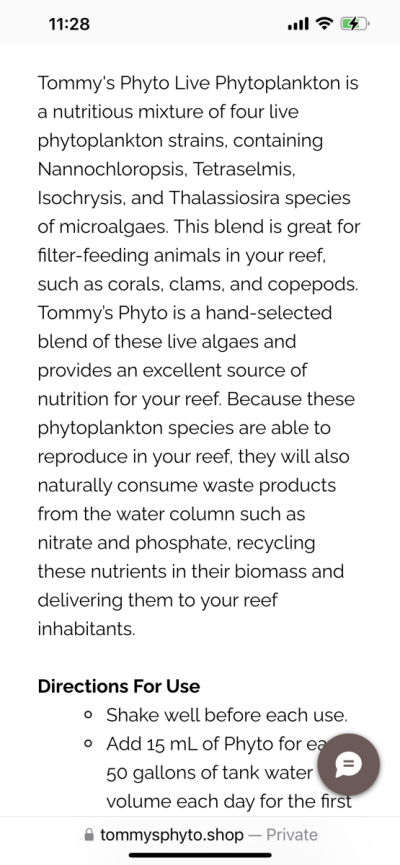What is Phytoplankton?
Microalgae, what we call phytoplankton, are aquatic, microscopic, single-celled, photosynthetic organisms. Similar to plants (their land counterparts), phytoplankton have chlorophyll in their cells, and generate food through the process of photosynthesis.
Phytoplankton are primary producers and form the foundation of virtually all marine food chains, supporting marine ecosystems and making other aquatic life possible. Phytoplankton is such an important piece of the biome both in the wild and in our aquariums, making phytoplankton an essential component to a balanced reef ecosystem.
Nutritional Value of Phytoplankton
Phytoplankton is an abundant source of macro- and micronutrients. You will find protein, carbohydrates, vitamins, lipids, and trace elements. One of the most important nutrients contained within phytoplankton cells are lipids, in particular Omega-3 fatty acids. Omega-3 fatty acids, often referred to as highly unsaturated fats (HUFA), are absolutely essential for the health and coloration of marine invertebrates and fish. Of these fatty acids, eicosapentaenoic acid or EPA (found generally in green-colored phytoplankton species) and docosahexaenoic acid or DHA (found generally in brown-colored phytoplankton species) are of critical importance to marine life, with DHA proving to be the more essential of the two. This is why our phyto buffet incorporates 5 brown strains, 4 green strains, and one red strain added for improved coral coloration.
When dosing phytoplankton in an aquarium, in order to obtain maximum nutrition, dosing multiple species with various nutritional profiles is important. A good dosing regimen for a reef aquarium is a
MINIMUM of one strain of a high-EPA (e.g., Chorella) and one strain of a high-DHA algae (e.g., Thalassiosira wiesflogii) to ensure that the aquarium inhabitants receive proper nutrition.
What Consumes Phytoplankton?
Whether in the wild or in aquariums, phytoplankton is a perfect food for: Corals, clams, feather dusters, scallops, tunicates and sponges, copepods, tube-worms, sea squirts, and other suspension-feeding invertebrates. In aquariums, regular dosing of phytoplankton increases the health, coloration, growth, and polyp extension of corals. It also increases the development and vibrancy of your marine life, and boosts zooplankton populations. Which increases the probability of establishing copepod colonies in your aquarium.
Maintaining Water Quality
Phytoplankton can play a major role in water quality and nutrient recycling through their consumption of nitrogenous wastes. Phytoplankton consume nitrogen and phosphorous to perform photosynthesis. In an aquarium environment, adding LIVE phytoplankton will reduce your nitrate (NO3) and phosphate (PO4) levels as the living phytoplankton consume these nutrients for photosynthesis.
Not only will live phytoplankton help reduce NO3 and PO4 levels, but through photosynthesis the phytoplankton help balance pH levels by increasing dissolved oxygen levels in the aquarium while simultaneously reducing carbon dioxide levels.
How drastically can phytoplankton affect water quality? It turns out, quite a lot! In fact, because phytoplanktons are so effective at nutrient uptake and because of their capacity for exponential growth, phytoplankton are sometimes utilized at municipal water treatment facilities to remove primary nutrients from sewage and wastewater. So, if phytoplankton can tackle sewage, just imagine the work that phytoplankton can do in your aquarium!
Outcompeting Nuisance Algae
A further benefit of dosing live phytoplankton in an aquarium is to help reduce or prevent nuisance algae growth (e.g., hair algae, bryopsis, cyano, etc.). Nuisance algae in aquariums consume the same nutrients as live phytoplankton to grow and survive. If live phytoplankton is dosed regularly and consumes these nutrients, the nuisance algae will eventually wither away.
What to Look for in a Quality Phytoplankton Product?
There are a lot of phytoplankton products on the aquarium market, and there is a lot of misinformation about what constitutes a quality phytoplankton product. If you are looking for a quality phytoplankton product that will give your reef the benefits of maximum nutrition, optimal water quality, and help reduce nuisance algae growth, then here's what you need to look for:
- MULTI-SPECIE BLEND
***For proper nutrition, you need to dose a MINIMUM of TWO species of phytoplankton.***
- EPA & DHA (GREENS & BROWNS)
**It is critical to dose BOTH high-EPA (typically "green") and high-DHA (typically "gold or brown") species.***
- LIVE (in contrast to concentrates, pastes, or cryopreserved)
***In order to receive the benefits of nutrient consumption, the product must be LIVE.***
- NO PRESERVATIVES, GELS, BINDERS, OR OTHER ADDITIVES
***Avoid products with additives that could be potentially harmful to your reef.***
If you are interested in a steady supply of phytoplankton and or zooplankton, you can purchase regularly, set up a subscription, or culture your own. There are costs and benefits to evaluate to determine which is right for your personal needs. With a set up like our Custom Culturing Kits a person can be successful with the proper instruction. My favorite reefer @Ocean_Queenie has successfully cultured two strains of phytoplankton and a nice population of Apocyclops copepods on her first attempt using this Kit.
Check out our selection at www.reefbysteele.com










